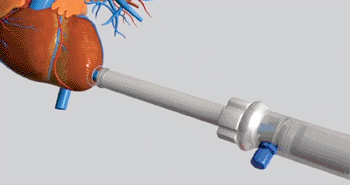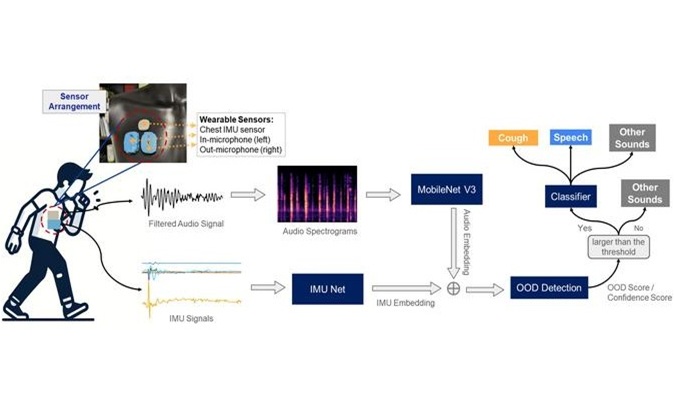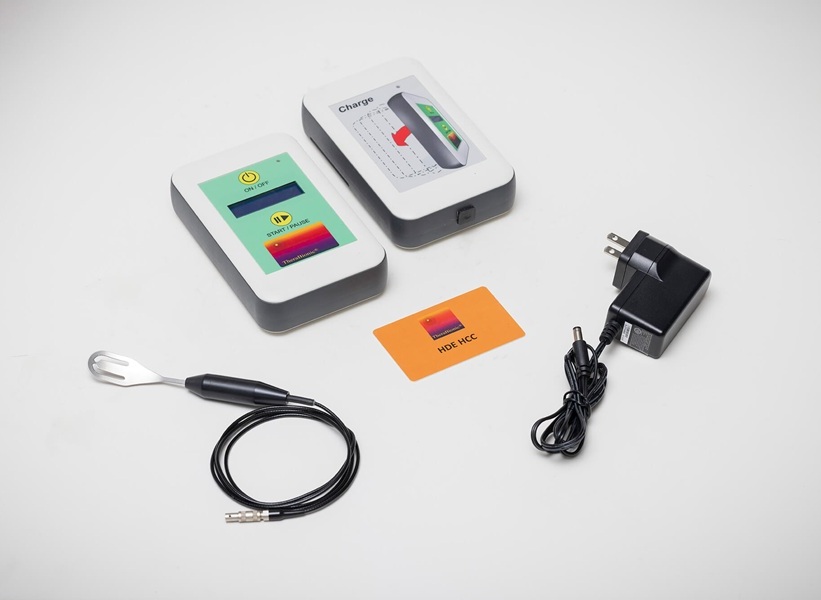Transapical Technology Facilitates Cardiac Surgery
|
By HospiMedica International staff writers Posted on 15 Oct 2013 |

Image: The Apica ASC system (Photo courtesy of Apica Cardiovascular).
A new surgical platform allows the delivery of aortic and mitral valves through the chest wall and the apex of the beating heart.
The Access, Stabilization, and Closure (ASC) system, in conjunction with minimally invasive surgical (MIS) techniques is used to deliver large-bore therapeutic devices into the beating heart of patients with structural heart disease, via the cardiac apex. The system both seals and stabilizes the tissue of the access site during therapeutic device delivery, minimizing loss of blood from, or induction of air to the beating heart. On completion of the therapeutic treatment, it standardizes apical access and closure, leading to safer heart operations, decreased procedure time, and reduced technical challenges associated with transapical access and closure.
A multicenter clinical trial conducted in Germany of the ASC system demonstrated an excellent safety profile with 100% technical success, superior ease-of-use for surgeons, and reductions in both blood loss and operative time. Follow-up assessments of patients showed that the system provided robust closure, with no postoperative apical bleeding complications and no degradation of left ventricular function. The ASC system is a product of Apica Cardiovascular (Galway, Ireland), and has received the European community CE marking of approval.
“Clinically, the Apica ASC System is easy to use, standardizing apical access and closure. Its ‘sutureless’ access coil minimizes both rib spreading and patient pain, providing a dry access site with no peri-sheath bleeding,” said Prof. Thomas Walther, MD, of the Kerckhoff Klinik (Hamburg, Germany), who participated in the device’s clinical study. “Apical closure was reliable, rapid, and completely dry, demonstrating a reduction in operative times, blood loss, use of blood products and apical access site complications.”
“Apica has provided an excellent example of how a new medical device, which was initially conceived and developed overseas, could be brought to Ireland and developed here so that it can be made available for export to treat patients globally,” said James Greene, CEO of Apica Cardiovascular.
The transapical transcatheter aortic valve implantation (TAVI) approach is used for patients whose arteries are too small or too diseased for the transfemoral approach. The delivery system is designed for replacement valve implantation via the apex of the heart, which is reached through a small incision made between the ribs just below the left nipple. It is then expanded using a balloon to fit across the stenotic aortic valve, holding it open permanently.
Related Links:
Apica Cardiovascular
The Access, Stabilization, and Closure (ASC) system, in conjunction with minimally invasive surgical (MIS) techniques is used to deliver large-bore therapeutic devices into the beating heart of patients with structural heart disease, via the cardiac apex. The system both seals and stabilizes the tissue of the access site during therapeutic device delivery, minimizing loss of blood from, or induction of air to the beating heart. On completion of the therapeutic treatment, it standardizes apical access and closure, leading to safer heart operations, decreased procedure time, and reduced technical challenges associated with transapical access and closure.
A multicenter clinical trial conducted in Germany of the ASC system demonstrated an excellent safety profile with 100% technical success, superior ease-of-use for surgeons, and reductions in both blood loss and operative time. Follow-up assessments of patients showed that the system provided robust closure, with no postoperative apical bleeding complications and no degradation of left ventricular function. The ASC system is a product of Apica Cardiovascular (Galway, Ireland), and has received the European community CE marking of approval.
“Clinically, the Apica ASC System is easy to use, standardizing apical access and closure. Its ‘sutureless’ access coil minimizes both rib spreading and patient pain, providing a dry access site with no peri-sheath bleeding,” said Prof. Thomas Walther, MD, of the Kerckhoff Klinik (Hamburg, Germany), who participated in the device’s clinical study. “Apical closure was reliable, rapid, and completely dry, demonstrating a reduction in operative times, blood loss, use of blood products and apical access site complications.”
“Apica has provided an excellent example of how a new medical device, which was initially conceived and developed overseas, could be brought to Ireland and developed here so that it can be made available for export to treat patients globally,” said James Greene, CEO of Apica Cardiovascular.
The transapical transcatheter aortic valve implantation (TAVI) approach is used for patients whose arteries are too small or too diseased for the transfemoral approach. The delivery system is designed for replacement valve implantation via the apex of the heart, which is reached through a small incision made between the ribs just below the left nipple. It is then expanded using a balloon to fit across the stenotic aortic valve, holding it open permanently.
Related Links:
Apica Cardiovascular
Latest Surgical Techniques News
- Novel Glue Prevents Complications After Breast Cancer Surgery
- Breakthrough Brain Implant Enables Safer and More Precise Drug Delivery
- Bioadhesive Sponge Stops Uncontrolled Internal Bleeding During Surgery
- Revolutionary Nano Bone Material to Accelerate Surgery and Healing
- Superior Orthopedic Implants Combat Infections and Quicken Healing After Surgery
- Laser-Based Technique Eliminates Pancreatic Tumors While Protecting Healthy Tissue
- Surgical Treatment of Severe Carotid Artery Stenosis Benefits Blood-Brain Barrier
- Revolutionary Reusable Duodenoscope Introduces 68-Minute Sterilization
- World's First Transcatheter Smart Implant Monitors and Treats Congestion in Heart Failure
- Hybrid Endoscope Marks Breakthrough in Surgical Visualization
- Robot-Assisted Bronchoscope Diagnoses Tiniest and Hardest to Reach Lung Tumors
- Diamond-Titanium Device Paves Way for Smart Implants that Warn of Disease Progression
- 3D Printable Bio-Active Glass Could Serve as Bone Replacement Material
- Spider-Inspired Magnetic Soft Robots to Perform Minimally Invasive GI Tract Procedures
- Micro Imaging Device Paired with Endoscope Spots Cancers at Earlier Stage
- AI Spine Model Could Reduce Surgical Risks
Channels
Critical Care
view channel
Origami Robots to Deliver Medicine Less Invasively and More Effectively
Delivering medicine to ulcers or other internal sites often requires invasive procedures that can disrupt surrounding tissues and lengthen recovery times. Traditional magnetic actuators used in soft robotics... Read more
Improved Cough-Detection Technology Aids Health Monitoring
Coughing serves as an important biomarker for tracking a variety of conditions and can help monitor the progress of respiratory diseases or predict when someone’s asthma is being exacerbated.... Read morePatient Care
view channel
Revolutionary Automatic IV-Line Flushing Device to Enhance Infusion Care
More than 80% of in-hospital patients receive intravenous (IV) therapy. Every dose of IV medicine delivered in a small volume (<250 mL) infusion bag should be followed by subsequent flushing to ensure... Read more
VR Training Tool Combats Contamination of Portable Medical Equipment
Healthcare-associated infections (HAIs) impact one in every 31 patients, cause nearly 100,000 deaths each year, and cost USD 28.4 billion in direct medical expenses. Notably, up to 75% of these infections... Read more
Portable Biosensor Platform to Reduce Hospital-Acquired Infections
Approximately 4 million patients in the European Union acquire healthcare-associated infections (HAIs) or nosocomial infections each year, with around 37,000 deaths directly resulting from these infections,... Read moreFirst-Of-Its-Kind Portable Germicidal Light Technology Disinfects High-Touch Clinical Surfaces in Seconds
Reducing healthcare-acquired infections (HAIs) remains a pressing issue within global healthcare systems. In the United States alone, 1.7 million patients contract HAIs annually, leading to approximately... Read moreHealth IT
view channel
Printable Molecule-Selective Nanoparticles Enable Mass Production of Wearable Biosensors
The future of medicine is likely to focus on the personalization of healthcare—understanding exactly what an individual requires and delivering the appropriate combination of nutrients, metabolites, and... Read moreBusiness
view channel
Philips and Masimo Partner to Advance Patient Monitoring Measurement Technologies
Royal Philips (Amsterdam, Netherlands) and Masimo (Irvine, California, USA) have renewed their multi-year strategic collaboration, combining Philips’ expertise in patient monitoring with Masimo’s noninvasive... Read more
B. Braun Acquires Digital Microsurgery Company True Digital Surgery
The high-end microsurgery market in neurosurgery, spine, and ENT is undergoing a significant transformation. Traditional analog microscopes are giving way to digital exoscopes, which provide improved visualization,... Read more
CMEF 2025 to Promote Holistic and High-Quality Development of Medical and Health Industry
The 92nd China International Medical Equipment Fair (CMEF 2025) Autumn Exhibition is scheduled to be held from September 26 to 29 at the China Import and Export Fair Complex (Canton Fair Complex) in Guangzhou.... Read more














